
-
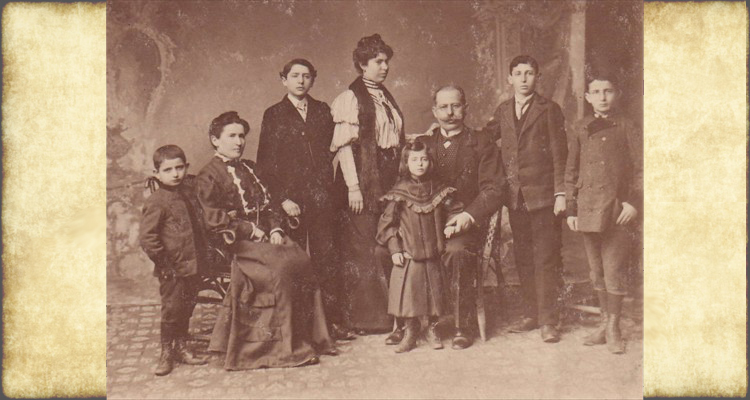 Left to Right: Max J., Berta Schafer J., Hugo J., Gisela J., Anna J., Siegmund J., Siegfried
J., Karl J.
Left to Right: Max J., Berta Schafer J., Hugo J., Gisela J., Anna J., Siegmund J., Siegfried
J., Karl J.
-

RIGHT: Reverse side of 1910 photo of Siegmund Jellinek
Translation of Printed and Handwritten words:
JOSEF HENK
Art Establishment for modern photography
OBERHOLLABRUNN
Bahn Street
in its own, separate building
Mr. and Mrs. Wilhelm Breier
Head of the [Jewish Community?] Cultural Organization
Respectfully dedicated
S Jellinek
Cantor and Religion Teacher
June 6, 1910
-

MIDDLE: Karl Jellinek in WWI, Austrian Army Uniform, inside Photo Studio in Italy, Next
to Sign About Sacrificing for Austria
This photo was probably taken between late 1914 and June 1915.
The German words which appear on the sign under the portrait of Kaiser [emperor] Franz
Joseph I are:
Mit Bluth im Kampf fürs Vaterland
Wir opfern Hab und Gut
Und solles auch verlangen
Den letzten Tropfen Bluth
Translation:
With blood in battle for the Fatherland
We sacrifice all of our possessions
And should it demand it
The last drop of blood.
TOP-RIGHT: Reverse side of one of the two extant photos of Karl Jellinek in army
uniform, in Italian photo studio
The logo of the C.Righetti photo studio in Trento, Italy and information about the location
and all of the studio's services appear in Italian on this reverse side of the
photograph.
BOTTOM-RIGHT: Reverse side of the second photo (photo-postcard) of Karl J. in army
uniform in Italian photo studio
Handwritten in the postcard's right (address) section:
[N.B. the English translation appears immediately after each German word or line of German
words]
Jellinek Karl
Kriegsfreiwilliger (volunteer soldier)
Abiturient (high school graduate who has been accepted into university)
Handwritten on the left side of postcard back:
�Kriegsfreiw.”'(abbreviation for Kriegsfreiwilliger - volunteer soldier)
Unterjäger (rifleman rank)
in 3. Kais. Tirol, ( in the third Kaiser Tirol)
Rgmt. (abbreviation for Regiment)
Handwritten upside down along bottom:
für die Kriegsmatura (for the war exam entitling the successful candidate to
proceed
to the university)
-
 This photo was probably taken between late 1914 and early 1917. There is
no inscription on the photo's reverse side.
This photo was probably taken between late 1914 and early 1917. There is
no inscription on the photo's reverse side.
Hugo is standing at the left end of the 4th (back) row. We see him looking straight ahead
with a serious expression, between the soldiers in the 3rd row standing second and third
from the left.
-
 Translation, transcription & additional information by Wilma Iggers
and Esther Bates
Translation, transcription & additional information by Wilma Iggers
and Esther Bates
LEFT: Hugo Jellinek, who served as a medic in the Austrian army, appears on the right
side of this WWI photo, along with two ambulance drivers.
However, Hugo wrote and
sent this photo-postcard after he was wounded in battle, captured by the Russians, and
recovering in a prison hospital in Samarkand, Uzbekistan. See also Hugo Jellinek's
biography for more information.
RIGHT: Reverse side of the photo.
Message:
Transcription of the original, old German, Sütterlin hand-writing:
Ein Andenken von Eurem Euch innig liebenden Hugo
English translation:
A memento from your Hugo, who loves you dearly.
Across the top of the card:
"Prisonnier de guerre" is written in French.
However, evidence that these words were hand-written by someone accustomed to writing in
Russian is provided by the crossing out of the loop of the letter "g", to make the
letter "d" in the middle word "de" of "Prisonnier de guerre."
The Russian Cyrillic alphabet uses the Roman letter "g" for the "d" sound.
English translation:
Prisoner of war.
The word written in the upper right stamp area of the card is the Russian word for
"Austria." The absence of a stamp in this space indicates that this postcard was
included in a batch mailing or a diplomatic pouch.
The transcription/translation of the address, which, line by line, is written first in
German and then in Russian:
Herrn S. Jellinek / Mr. S. (referring to Siegmund Jellinek) -- Yellinek
Hollabrunn (name of town, NW of Vienna) -- Hollabrunk
N. Oe., (abbreviation for Nieder Österreich) / -- Yuzhnaya Avstriya
English translation: Lower Austria -- southern [?] Austria
-
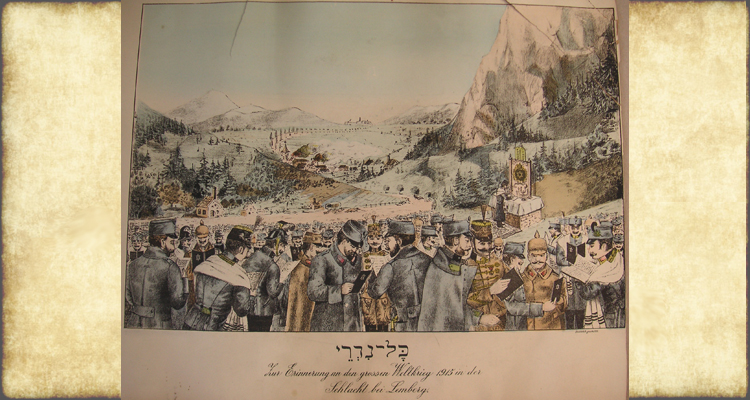 This reproduction of an ink and watercolor wash painting was used as
backing material for Karl Jellinek's 1922 Doctor of Law diploma. It had been cut
slightly on its right side, to fit underneath the diploma. The print was discovered in 2007,
when the diploma was removed from its frame and glass covering in order to photograph it.
This reproduction of an ink and watercolor wash painting was used as
backing material for Karl Jellinek's 1922 Doctor of Law diploma. It had been cut
slightly on its right side, to fit underneath the diploma. The print was discovered in 2007,
when the diploma was removed from its frame and glass covering in order to photograph it.
The title of the print, written in Hebrew, is "Kol Nidre" (English: All
Vows), the name and opening words of the first prayer that ushers in the service (known also
as "Kol Nidre"), on the eve of the Yom Kippur (Day of Atonement) holy day.
The English translation of the German words under the title are:
In memory of the great world war in 1915 at the Battle of Lemberg.
The small German words in the lower right corner under the picture are:
"Gesetzlich geschützt" ("Protected by law").
-
 The formal opening ceremony of The Hebrew University of Jerusalem took
place on Mt. Scopus on April 1,1925. Karl Jellinek was present at this historic event,
representing the Zionist association he presided over at the time: Der Lese -und
Redehalle, jüdischer Hochschüler, in Wien (The Reading and Lecture Hall [Association] of
Jewish [University] Students in Vienna).
The formal opening ceremony of The Hebrew University of Jerusalem took
place on Mt. Scopus on April 1,1925. Karl Jellinek was present at this historic event,
representing the Zionist association he presided over at the time: Der Lese -und
Redehalle, jüdischer Hochschüler, in Wien (The Reading and Lecture Hall [Association] of
Jewish [University] Students in Vienna).
Karl was proud to have been present there, among the leaders and representatives of world
Jewry. He often said “this day was one of the happiest days of my life.” Karl was glad to
point out that he was discernible among the crowd in this photo, because he was standing
near the flag-bearer of the Zionist Academic Society of Warsaw, and the photographer’s focus
seemed to have included the area of that flag-bearer.
Karl Jellinek can be identified in the cropped view in the next image, by the blue circle
around him.
-

LEFT: Close-up of Karl Jellinek from the previous image.
RIGHT: Close-up of photographer’s insignia and some of ceremony onlookers, seen in the
bottom, left-of-center of the full image.
The top line of the insignia seems to be the photographer’s logo or monogram.
“Arushkes” is written in Yiddish on the next line. Zvi Arushkes Oren of “Arushkes
Photography, Tel Aviv - Jaffa” created many photographs of significant events in the
development of the Jewish community in 1920s Palestine. The last line of this particular
photograph's insignia in Hebrew, reads “Tel Aviv,” followed by an abbreviation, which
may stand for Arushkes Photography's Tel Aviv studio address of
“Allenby [Street] 1.”
-
![ABOVE LEFT: March 1929, Group photo of members of the Zionist and Jewish cultural fraternity "<i>Die Lese - und Redehalle jüdischer Hochschüler in Wien</i>" -- (translated as "The Reading and Lecture Hall [Association] of Jewish [University] Students in Vienna" and hereafter referred to as the "Halle,") -- at the 70th Semester Commemoration/Celebration of its Founding. ABOVE LEFT: March 1929, Group photo of members of the Zionist and Jewish cultural fraternity "Die Lese - und Redehalle jüdischer Hochschüler in Wien" (translated as "The Reading and Lecture Hall [Association] of Jewish [University] Students in Vienna" and hereafter referred to as the "Halle,") -- at the 70th Semester Commemoration/Celebration of its Founding.](data1/images/18karlhalle.jpg)
This Viennese Jewish association was founded in September 1894 under the name of
"Jüdische akademische Lesehalle in Wien," but the name was changed in
1899 to the longer name above. The Nazis 'officially' dissolved the
"Halle" and expropriated its extensive library starting from the end of
August and lasting until mid-September 1938. You can view evidence
of these persecutory actions by the Nazi regime and also read more about the history and
development of the "Halle" by clicking here to go to the supporting document,
"Dissolution by the Nazis of the Reading and Lecture Hall for Jewish University
Students in Vienna ‐ August and September 1938."
Under the "Halle's" official emblem on the back wall of this basement meeting
room, hang the photos of the following Zionist leaders: Theodor Herzl, the activist
founder of modern political Zionism (on right), Max Simon Nordeau*,
co-founder with Theodor Herzl, of the World Zionist Organization, (on left), and Chaim
Weizmann**, important Zionist leader and President of the World Zionist
Organization at the time of this photo (below).
* This identification is based on Nordeau's importance as a Zionist and historic photos
of him.
**The identification of Weizmann is based on his significant role in the Zionist movement
and examination of the enhanced photo of him in the close-up on the right side of this Image
page.
TOP RIGHT: Close-up view of Dr. Karl Jellinek with two other "Halle" member
celebrants. This view can help the viewer locate Karl in the third row of the full group
photo, standing a little to the right of center, earnestly facing towards his right,
wearing glasses and a tuxedo. We have documentary evidence of Dr. Jellinek's
presidency of this organization between 1923 and 1927, but it is likely that he
continued to be president until the end of the 1920s and into the early 1930s. He was
the group's delegate to the opening ceremony of Hebrew University on Mt. Scopus,
Jerusalem in 1925. The two preceding photos in the Image section of this website show
this April 1925 ceremonial opening, in which Karl can also be discerned among the
attendees.
MIDDLE RIGHT: Close-up of the "Halle's" distinctive emblem, and the
framed portrait centered beneath the emblem. This detail of the full group photo
has been darkened so that the viewer can see the "Halle's"
monogram in the lower right quadrant of the emblem, as well as hints of the
framed portrait hanging below the emblem and between the bottom ends of the flag
holders. Note the ornamental flourishes beneath and above the
"R". The " Rh! " stands for the key word
"Redehalle" in the organization's name. The blue and
gold-like colors that were in the emblem are approximated in the photo
illustration in Dr. Gatscher-Riedl's historical article, now appearing in the
bottom portion of the document referenced above: "Dissolution by the
Nazis of the Reading and Lecture Hall for Jewish University Students. . .
"
BOTTOM RIGHT: Reverse side of "Die Lese - und Redehalle jüdischer
Hochschüler in Wien" Founder's Day group photo.
The names handwritten on the left side include "Dr. Karl Jellinek," as well
as fraternity brothers "Dr. [Joshua] Kohlberg" and [Rabbi]
"Heitner," who emigrated to Mandate Palestine from Vienna, and with whom
Karl corresponded for many years and met again in Israel in 1972. The words
"70th Semester Stiftungsfest der 'Halle' March 1929" (70th
semester Foundation Festival of the "Hall") were written by Karl, probably
many years later in the USA.
The Austrian historian, Dr. Gregor Gatscher-Riedl, revealed to this writer, that the
"Atelier Rosa" refers to the studio of Rosa Sághi, society
photographer at that time, who specialized in sittings under electrical light. Rosa
Sághi worked with a lot of Jewish artists, among them, the influential
Viennese lyricist and author, Peter Altenberg.
-
 Photo taken in
front of Siegmund and Berta Schafer Jellinek's home/synagogue in Hollabrunn, Austria, on
the occasion of their 50th Wedding Anniversary.
Photo taken in
front of Siegmund and Berta Schafer Jellinek's home/synagogue in Hollabrunn, Austria, on
the occasion of their 50th Wedding Anniversary.
[The name "Jellinek" will be represented by "J." in the identification below
of the family members in this photo. The names of the progenitors, Siegmund and Berta S. J.,
as well as their six adult children have been bolded.]
Top row standing: Anna J. Nadel & Miron Nadel, Karl J., Stella Pollak J. &
Max J., Martha Hirschensohn J. & Siegfried J.
Middle row: Gisela J. Schlesinger, Berta Schafer J. & Siegmund J.,
Hugo J., Leopold (Poldi) Schlesinger.
Front row: Gisella Nadja J., Anna J., Erich J., Berta J.
-
 Additional
photo taken in front of Siegmund and Berta Schafer Jellinek's home/synagogue in
Hollabrunn, Austria, on the occasion of their 50th Wedding Anniversary, and the occasion of
Gisella Nadja Jellinek's becoming Bat Mitzvah. Anna Jellinek Nadel's husband, Miron
Nadel, was the photographer.
Additional
photo taken in front of Siegmund and Berta Schafer Jellinek's home/synagogue in
Hollabrunn, Austria, on the occasion of their 50th Wedding Anniversary, and the occasion of
Gisella Nadja Jellinek's becoming Bat Mitzvah. Anna Jellinek Nadel's husband, Miron
Nadel, was the photographer.
This photo and the preceding group photo of the more closely-related family members are
the last extant Jellinek/Schafer family group photos.
Please note:
• The name "Jellinek" will be represented by "J." in the
identification below of family members.
• "[...?]" represents a completely unidentified person, or an unknown maiden
or married name.
• The names of Siegmund and Berta J. and of their six grown children, are in bold
type.
Seated in front row, on area rug on ground: Gisella Nadja J., Anna J., Erich J., Berta J.
Seated 2nd row: Gisela J. Schlesinger, Berta Schafer J., Siegmund J.,
Charlotte [...?] (Siegmund J.'s cousin), Eduard J. (Siegmund J.'s brother), Gustav
J. (son of Siegmund J.'s sister, Jetti J. and [...?])
Standing 3rd row: Willy J. (grandson of Siegmund J.'s sister Jetti J./son of Oskar J.
and his wife, Berta [...?] J.), Karl J., Anna J. Nadel, Stella Pollak J. (Max
J.'s wife), Frieda Schafer Epstein (daughter of Berta S. J.'s brother, Max Schafer,
and his wife, Paulina [...?] Schafer), Martha Hirschensohn J. (Siegfried J.'s wife),
Artur J. (son of Siegmund's brother, Eduard J. and his wife, Katerina Strebinger J.),
Leopold Schlesinger (Gisela J. Schlesinger's husband), Hugo J., Siegfried
J., Ignatz J. (son of Siegmund's sister, Jetti J. and [...?])
Standing 4th row: Elsa [...?] J. (Ignatz J.'s wife), woman with wide-brimmed hat [...?].
Standing 5th row: Oskar J. (son of Siegmund's sister, Jetti J. and [...?]), Berta [...?]
J. (Oskar J.'s wife), Ruth Pollak [...?] (Stella P. J.'s sister), Ilsa [...?]
(Siegmund J.'s cousin),
Max J.
Standing 6th row: Charlotte [...?] Schafer (wife of Siegfried Schafer, who was Berta Schafer
J.'s brother), Siegfried Schafer (Berta Schafer J.'s brother), man at right end of
row [...?]
-
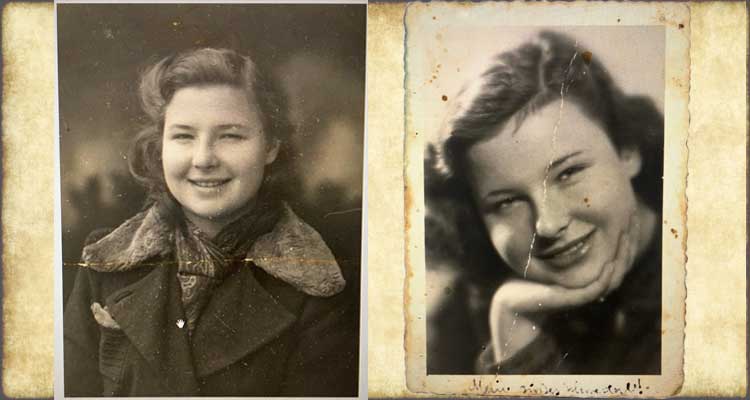
Berta
and Anna's
photos appear along with Gisella Nadja Jellinek Gal's written testimonies, on this
Yad Vashem online database. The reader can access the testimony about Berta by
clicking once on her name, typed in blue above, and then clicking a second time on her name
in the database Results section that will appear. For the testimony about Anna,
please follow the same procedure. For more information on how Gisella Nadja escaped the Nazi
genocide, please see Gisella
Nadja's brief Biography page.
Left:
It is difficult to date this photo because Berta looks so much younger in this website’s
family group photos of 1933, and in her Confirmation photo of 1935, she
looks quite a bit older and has a less round face. It is possible that Gisella Nadja made a
mistake and this photo is of Anna. If this is indeed Berta, the latter part of 1934 is a
best guess for the time that this photo was taken, when Berta would have been twelve years
old and living with her paternal grandparents, two sisters and father in OberHollabrunn,
(aka Hollabrunn) Austria.
Right:
This appears to have been a studio portrait, posed and lit artificially. However, Anna’s
warmly smiling mouth and eyes, her sweetness, innocence and contentment seem quite genuine
and sincere. Gisella Nadja inscribed at the bottom “Meine süsse Schwesterl!” (My
sweet little sister). The “l” added to “Schwester” gives it the Yiddish
diminutive ending. This photo may also have been taken in late 1934, when Anna would have
been ten and 1/2 years old, and living together with her two older sisters, Berta and
Gisella Nadja, her father and her grandparents in OberHollabrun (aka Hollabrunn).
-
 Daughters
left to right: Gisella Nadja, Berta, Anna. On occasion of Berta's Confirmation.
Daughters
left to right: Gisella Nadja, Berta, Anna. On occasion of Berta's Confirmation.
Handwritten inscription on reverse side of photo (not shown):
"Andenken an die Confirmation der Bertha -- -- Juni 1935"
Translation: Memory of Berta's Confirmation -- June 1935.
This inscription was probably written by Miron Nadel (Hugo's brother-in-law), who was
the photographer. Miron Nadel's name and the Mariahilferstrasse address of his Viennese
photo studio is stamped to the right of the inscription.
-
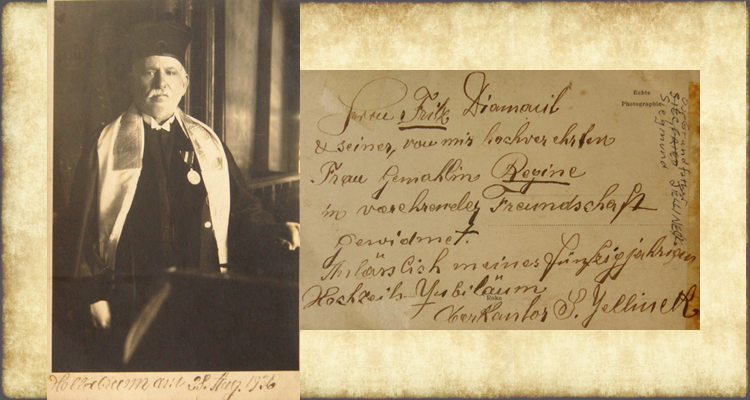 Siegmund J. is wearing his cantorial attire and his government medal
received for counselling WWI veterans. His expression appears contemplative and somewhat
sad.
Siegmund J. is wearing his cantorial attire and his government medal
received for counselling WWI veterans. His expression appears contemplative and somewhat
sad.
RIGHT: Inscription on the reverse side of photo, handwritten by Siegmund J. to Fritz and
Regine Diamant
Transcription:
[the following transcription, translation and explanatory note re:
"hochverehrten" and "Frau Gamahlin" were completed with the
generous help of Esther Bates and Wilma Iggers]
Herrn Fritz Diamant
& seiner, von mir hochver ehrten [sic] Frau Gemahlin Regine
in varehre[neler?] Freundschaft
gewidment.
Anlässlish[sic] meines fünfzigjahrigen
Hochzeit Jubiläum
Oberkantor S. Jellinek
Translation:
To Mr. Fritz Diamant and his wife, Mrs. Regine, for whom I have the very highest regard
["Hochverehrten" is an extreme expression of respect or honor. Siegmund's
use of "Frau Gemahlin" before the name, Regine, added a still higher degree
of respect.]
dedicated in honored [or "honorable"] friendship
on the occasion of my fiftieth wedding anniversary.
[This is a puzzling part of this dedication, because we believe that Siegmund and
Berta's 50th wedding anniversary was in 1933, and this photo is captioned by Siegmund as
"Hollabrunn, 1936".]
Chief Cantor, S. Jellinek
-
 Siegmund J. in his
cantorial attire, and wearing the medal he had received from the Austrian government.
Hollabrunn, Austria,1937.
Siegmund J. in his
cantorial attire, and wearing the medal he had received from the Austrian government.
Hollabrunn, Austria,1937.
There is a handwritten dedication on the reverse side of this photo written by
Siegmund's son, Siegfried J.:
"Mein geliebtes Vaterl in Alter von 80 jahren. Hollabrunn, 1937. Oberkantor S.
Jellinek."
Translation: My beloved father at 80 years old. Hollabrunn, 1937. Chief cantor, S. Jellinek.
-
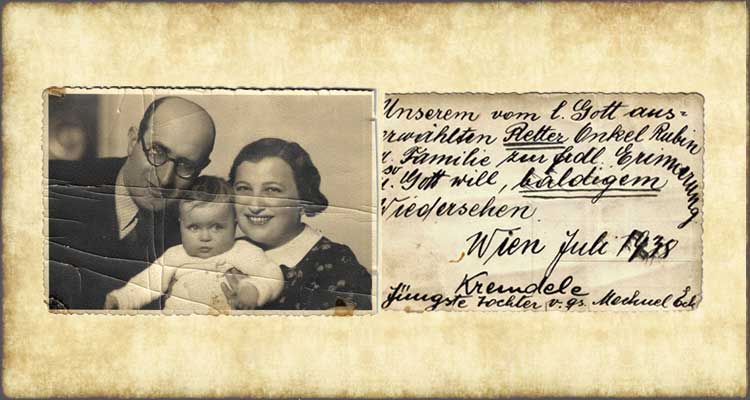
RIGHT: Hand-written dedication on the reverse side of the photo;
Transcription:
Unserem vom lieben Gott aus-
erwählten Retter Onkel Rubin
und Familie zur frdl. [freundlich] Erinnerung
und so Gott will, baldigem
Wiedersehen.
Wien Juli 1938
Kreindele
Jüngste Tochter v.[vom] gs.[gestorbenen] Mechuel Eck[stein].
Translation:
To Uncle Rubin, our savior
chosen by dear God,
and family, as a warm memory
and, God willing, [toward an] early
reunion.
Vienna, July 1938
Kreindele
Youngest daughter of the late Mechuel Eck[stein]
Transcription and Translation by Susan Gould
Kreindel's effusive gratitude expressed here can be understood in the context of her
knowing that her uncle Rubin had agreed to send affidavits, which would allow her family to
obtain a US visa and allow their escape from Nazi -occupied Austria and save their lives!
Kreindel could not have known at that time that not all affidavit submissions would result in
the granting of US visas and that she and her family would be among the lucky ones
whose submission of affidavits would result in the receipt of US visas.
Kreindel may have used the Yiddish diminutive form of her name (adding the "e" at
the end) both to subordinate herself and thus endear herself further to her uncle, and
because she thought that at that point, Rubin may have known about her only from early
correspondence with her father, Michael Eckstein/Rubin's brother, in which Michael would
have referred to her as "Kreindele" because she was very young.
Rubin and Michael Eckstein had ventured to the US early in the 20th century to
explore prospects for immigration. Rubin stayed and succeeded in co-founding a bank, which
he helped develop to become The Bank of North America. Michael, however, found the cramped
conditions, the sweltering summer heat and the altogether very different life in New York
City's Lower East Side intolerable. He therefore returned to his hometown of Stanislau, then
in the Galician region of the Austro-Hungarian Empire. Michael could not know that not long
thereafter, he would be conscripted to a much less tolerable fate of soldiering for Austria
and becoming severely wounded in WWI. Nor could Michael have known that his wife, Mathilde,
widowed in 1922, would remain in Europe and would not be able to escape her murder by the
Nazis in 1942.
Rubin later sent affidavits for another niece/Kreindel's sister, Anna Clara and her
family, but perhaps, tragically not knowing how much of a matter of life and death his
affidavits were to other family members still in Europe, and possibly, because of his
wife's reluctance, Rubin would not send any more affidavits after Anna Clara's.
Later, upon her arrival in the NYC, Kreindel, now called Caroline, worked
in the bank which Rubin Eckstein and Jacob Leichtman had founded and enlarged.
To read more about Rubin Eckstein's providing the affidavits and proof of his financial
status, that the US State Dept. required, please see this website's primary document:
Correspondence Concerning US
Affidavit and Visa for Karl Jellinek and Family. For more information about Rubin
Eckstein, see his October
1966 obituary in the New York Times:
-
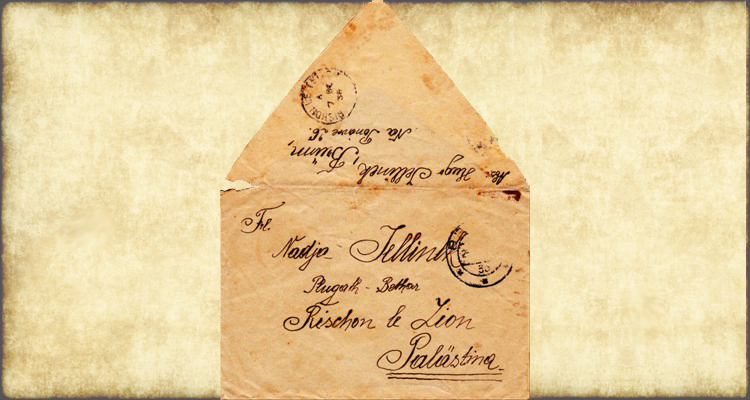 It is interesting to see this example of Hugo's beautiful
calligraphic handwriting in modern script, instead of the old German Sütterlin
script that he also masterfully used in the body of his letters. We can tell from the
"BR" (Brünn) postmark that the letter was posted on the 25th day of a month in
1938. The more completely legible "Rishon LeTsion" postmark reveals that this
envelope arrived in Rishon on December 7, 1938. November is therefore most likely the
month in which this envelope was posted in Brünn, and the letter inside was most likely
Hugo's letter dated November 24, 1938. The Hebrew
words "Plugath - Bethar" in the address denote the Betar Zionist youth group
to which Nadja belonged. "Frl." is an abbreviation for
"Fräulein" (English: young lady, girl, Miss) and "Abs:"
is an abbreviation for "Absender" (Sender).
It is interesting to see this example of Hugo's beautiful
calligraphic handwriting in modern script, instead of the old German Sütterlin
script that he also masterfully used in the body of his letters. We can tell from the
"BR" (Brünn) postmark that the letter was posted on the 25th day of a month in
1938. The more completely legible "Rishon LeTsion" postmark reveals that this
envelope arrived in Rishon on December 7, 1938. November is therefore most likely the
month in which this envelope was posted in Brünn, and the letter inside was most likely
Hugo's letter dated November 24, 1938. The Hebrew
words "Plugath - Bethar" in the address denote the Betar Zionist youth group
to which Nadja belonged. "Frl." is an abbreviation for
"Fräulein" (English: young lady, girl, Miss) and "Abs:"
is an abbreviation for "Absender" (Sender).
-
 Photograph
taken before Karl J., Kreindel/Karla Eckstein J. and infant daughter, Michaela J.'s
life-saving departure from Vienna.
Photograph
taken before Karl J., Kreindel/Karla Eckstein J. and infant daughter, Michaela J.'s
life-saving departure from Vienna.
Standing, Left to Right: Clara Anna E. Bertisch (Kreindel/Karla’s older sister), Karl J.,
Kreindel/Karla E. J.
Sitting, Mathilde/Manzie Eckstein (Kreindel and Clara’s mother), holding her grandchildren
on her lap; Israel Bertisch (Clara's son) on Mathilde’s right side, and Michaela J.(Karl
and Kreindel's daughter) on Mathilde's left.
-
 Anna sent this small photo from Brünn to her uncle and aunt, Karl
and Karla Jellinek, in New York City. Anna is almost 15 years old here. She is not smiling,
but rather her face shows a mix of seriousness, sadness, disillusionment, resignation and
strength.
Anna sent this small photo from Brünn to her uncle and aunt, Karl
and Karla Jellinek, in New York City. Anna is almost 15 years old here. She is not smiling,
but rather her face shows a mix of seriousness, sadness, disillusionment, resignation and
strength.
RIGHT: Inscription Handwritten by Anna in 'modern' German script.
Translation:
My dear uncle Karl and dear aunt Karla
in remembrance of your loyal niece
Anny
Brünn, February 8, 1939
-
 Berta sent this photo from Brünn to her uncle and aunt, Karl and
Karla Jellinek, in New York City. This small portrait photo of Berta shows her at about 16
1/2 years old, with an open, wistful and gently smiling expression.
Berta sent this photo from Brünn to her uncle and aunt, Karl and
Karla Jellinek, in New York City. This small portrait photo of Berta shows her at about 16
1/2 years old, with an open, wistful and gently smiling expression.
RIGHT: Inscription hand-written by Berta in old German, [Sütterlin] script.
Transcription of Berta’s old German script:
Meinem geliebten Onkel u. Tante und meiner Pl. reizenden Cousine zum Erinnerung von Eurer
treuen Nichte
Berta.
Translation:
My beloved uncle and aunt and my [platterdings - absolutely?]
charming cousin
in memory of your loyal niece
Berta
Brünn, February 21, 1939
-
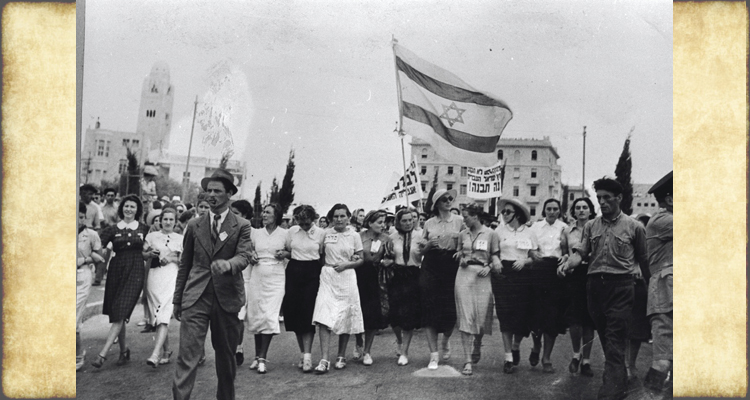 This photo, officially titled, “Women Protesting Against the White
Paper, 18, May 1939,” was photographed by Rudolf Yunes. The photo appears here with the
permission of the KKL - JNF (Keren Kayemet LeIsrael - Jewish National Fund) Photo Archives.
This photo, officially titled, “Women Protesting Against the White
Paper, 18, May 1939,” was photographed by Rudolf Yunes. The photo appears here with the
permission of the KKL - JNF (Keren Kayemet LeIsrael - Jewish National Fund) Photo Archives.
Nadja Jellinek, is the eighth woman in from the right side of the photo, near the photo's
center. She is facing forward with a stern and resolute expression. She is wearing a white
dress, pinned to which is a badge with the Hebrew word “sadran” (an official
appointed to supervise arrangements or to keep order at a large public event).
The White Paper, which was a Palestine policy paper issued and approved by Neville
Chamberlain’s government on May 23, 1939, severely limited immigration into Palestine to a
regular quota of 10,000 a year, and a total of 75,000 in the following five years.
This policy was adopted at a time when Jews in Central Europe desperately needed to escape
from Nazi persecution and murder. In Nadja's letter to
her father, Hugo Jellinek, of June 3,1939, Nadja wrote, (referring to the White
Paper’s 75,000 immigrant quota for 1939 - 1944):
“That is such nonsense, we say; in this year alone, that many will come over, but meanwhile
we do not talk about it, because we have so much to do...”
Seventy-four years later, in October 2013, Nadja recalled her two Betar commanding
officers (seen marching in front of the women), and the Betar women members with whom she
had locked arms and marched.
-
 Photograph of Hugo J. and Fritzi Fränkel, hands clasped together,
on the day of their engagement in Brünn (Brno), Czechoslovakia.
Photograph of Hugo J. and Fritzi Fränkel, hands clasped together,
on the day of their engagement in Brünn (Brno), Czechoslovakia.
RIGHT: Messages to Karl and Kreindel/Karla J., handwritten by Fritzi Fränkel and
Hugo J., on the back of their Engagement photo, dated August 20,1939
Translation of
messages:
Dear brother and sister! Brno, 8/20/1939
On the day of our engagement
Permit me, with my beloved Hugole [affectionate diminutive form of Hugo’s name] in a hardly
accomplished photograph, to introduce myself, and to express the hope that we will soon get
to know each other personally, which would give me great pleasure.
With all my heart
Your Fritzi
Dear Karl and dear Karla!
I hope that you enjoy this picture! Send photos as well!
Kisses
Your Hugo
-
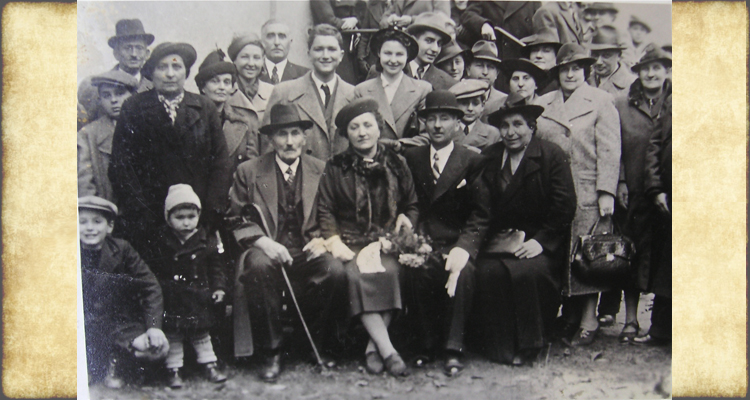 Group wedding day photo taken on October 22, 1939, in Brno (Brünn).
The city was then in the "German Protectorate of Bohemia and Moravia,"
formerly western Czechoslovakia.
Group wedding day photo taken on October 22, 1939, in Brno (Brünn).
The city was then in the "German Protectorate of Bohemia and Moravia,"
formerly western Czechoslovakia.
The man holding a cane, and seated on the left side of the first row, might be Fritzi's
father or Hugo's uncle, Eduard Jellinek. Fritzi and Hugo are seated in the middle of
this row. Hugo's youngest daughter, Anna Jellinek, is smiling and standing directly
behind and in-between Fritzi and Hugo. A smiling young man stands to Anna's right.
Hugo's middle daughter, Berta Jellinek, smiles and stands a little behind and to the
young man's right. The young man is likely Heinz Rosenzweig, Fritzi's nephew
and Berta and Anna's new cousin.
The woman wearing the tall dark hat and standing a little in front of and to Berta's
right, may be Fritzi's niece, Olga Zwicker Havlova, who survived the Shoah. In a 1965
letter that Olga wrote to Gisella Nadja, she identified herself as Fritzi's niece.
Olga's letter, in which she tells of her imprisonment in the Lenzing concentration camp
for women and of having known Hugo Jellinek well, will be posted to this website in the
future.
-
 Additional wedding day group photo taken on October 22, 1939, in Brno
(Brünn), then in the "German Protectorate of Bohemia and Moravia,"
formerly western Czechoslovakia.
Additional wedding day group photo taken on October 22, 1939, in Brno
(Brünn), then in the "German Protectorate of Bohemia and Moravia,"
formerly western Czechoslovakia.
Seated in the first row are, from left to right: the oldest man seen in the photo, who may
be Fritzi's father (or Hugo's uncle, Eduard Jellinek), an (unidentified) woman (who
now has the youngest child in the photo on her lap), and Hugo's youngest daughter, Anna
Jellinek. Fritzi and Hugo stand directly behind Anna and the unidentified woman. Hugo's
middle daughter, Berta Jellinek, is standing and smiling directly behind the oldest man. The
hatless, smiling young man (likely Hans Rosenzwieg) standing behind and to Berta's right now
has his hand on Berta's collar. The woman wearing the tall dark hat and standing third
from left in the second row may be Fritzi's niece, Olga Zwicker Havlova, who survived
the Shoah.
The tragic probability is that almost all of the other people in this group (those
identified and those who, sadly, remain unidentified), who came together to celebrate a
union of love, were separated and murdered within the following four years by the
hate-filled Nazis and their collaborators.
-
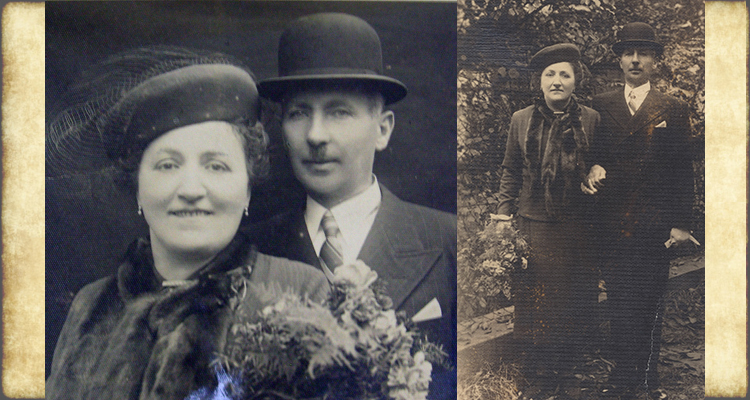 The range of facial expressions, especially Fritzi's, in these and
in the wedding day group photos, reflects the fact that this wedding occurred fifty-two days
after the outbreak of WWII and approximately seven months into the Nazi occupation of Brno.
Overall, however, Hugo and Fritzi's love and marriage seem, to this writer, to be a
testament to the strength of their resilience and spirit of defiance.
The range of facial expressions, especially Fritzi's, in these and
in the wedding day group photos, reflects the fact that this wedding occurred fifty-two days
after the outbreak of WWII and approximately seven months into the Nazi occupation of Brno.
Overall, however, Hugo and Fritzi's love and marriage seem, to this writer, to be a
testament to the strength of their resilience and spirit of defiance.
-
 It is impossible to reconcile this portrait of seventeen-year-old Berta, whose smiling eyes
and lips are so imbued with life and anticipation of life, with her murder at Auschwitz less
than three years later. Here, we see a beautiful young woman, looking innocently and
engagingly into a studio camera, unaware of the terror and death that lay ahead for her, her
sister Anna, her father, Hugo and her new stepmother, Fritzi.
It is impossible to reconcile this portrait of seventeen-year-old Berta, whose smiling eyes
and lips are so imbued with life and anticipation of life, with her murder at Auschwitz less
than three years later. Here, we see a beautiful young woman, looking innocently and
engagingly into a studio camera, unaware of the terror and death that lay ahead for her, her
sister Anna, her father, Hugo and her new stepmother, Fritzi.
In the lower right corner of the photo, we see the imprinted logo of the Czech STOKLAS
[photo] STUDIO, 16, BRNO,
On the reverse side of the photo, we see that Berta addressed it to "Mr. Dr. Karl
Jellinek, New York" Berta's inscription can be translated as:
My dear aunt and dear uncle,
A heartfelt remembrance of your grateful niece
Bert
Brünn, [Brno, Czechoslovakia] December 24, 1939.
Berta may have written "your grateful niece" because of kindness and generosity
shown to her by Karl and Karla Jellinek between 1930 and 1939 when she and they were living
in Vienna and Hollobrunn, Austria. Her gratitude might also have been related to her
anticipation of an affidavit that she hoped to obtain from Karl and Karla.
-
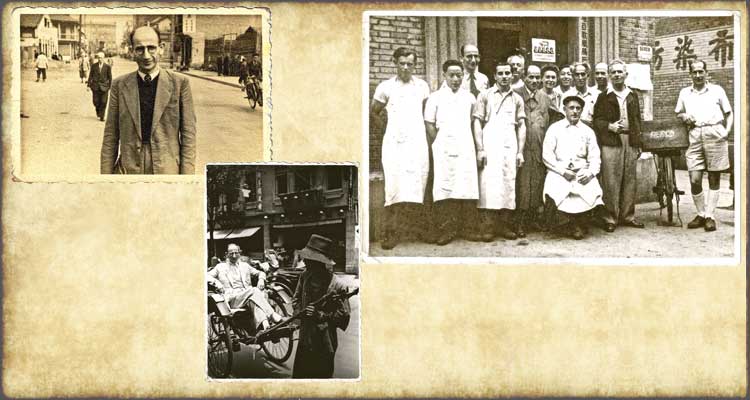 The above photos,
shot during Max's nearly eight years in exile in Shanghai, China, contrast with
Max's Biography page photo, shot in pre-Nazi Vienna,
in which he appears self-confident and debonair. After reading of Max's hardships in
Shanghai, in his letters of April 23, 1939 and May 16, 1939, one can well understand Max's loss of
weight and much older appearance in these three photos.
The above photos,
shot during Max's nearly eight years in exile in Shanghai, China, contrast with
Max's Biography page photo, shot in pre-Nazi Vienna,
in which he appears self-confident and debonair. After reading of Max's hardships in
Shanghai, in his letters of April 23, 1939 and May 16, 1939, one can well understand Max's loss of
weight and much older appearance in these three photos.
LOWER CENTER: In Rickshaw
Whoever snapped this photo caught Max' with his brow wrinkled in seeming worry, doubt or
displeasure. But Max's discomfort was perhaps exacerbated by the strong noon-time sun,
or by his feeling sick, or by his difficulty communicating with the rick-shaw driver. Signs
identifying the Tongliyuan Restaurant can be seen on the other side of the street.
UPPER LEFT: Smiling in the middle of the road
Max is posing for this photo, standing and warmly smiling in the middle of a wide road with
a bicylist but no cars, in an area of Shanghai with local Chinese people and foreigners.
UPPER RIGHT: Group Photo of Staff of BERCO Sausage Factory
Max's smiling face and tie can be seen in the back row. The German sign, situated above
the workers' heads, identifies the building as the BERCO Sausage Factory. The
Chinese characters in the vertical sign to the right of the German sign, give the name of
the company as Peiyage Lachang Suo, which translates similarly, to BERCO
Sausage Institute/Factory. Judging from his dress, Max must have worked in the
office of this factory, performing one of the jobs he secured before his last Shanghai job
as a radio announcer and reporter.
The three Chinese characters on the separate building wall to the right translate as
Fabric Dyeing Shop.
Many thanks to Haverford College Professor, Shizhe Huang, who
very generously translated the Chinese characters and added more historical information
about them than I could include here.
-
 Siegfried appears posed, but relaxed and somewhat detached in this
studio portrait.
Siegfried appears posed, but relaxed and somewhat detached in this
studio portrait.
The handwritten text on the reverse side of this photo reads, in German:
Meinem geliebten Bruder Hugo!
Aufgenommen 15 / IX. 1926
Translation:
My beloved brother Hugo!
Photographed September 15, 1926
There is also a stamp of the Henk Studio, which includes the names of the photo studio's
branches in the small municipalities of Stockerau and Retz in the Hollabrunn District of
Lower Austria.
TOP-RIGHT: Siegfried Jellinek Portrait Photo, Lwów, January 1941
This photo is only one and three-sixteenths inches high, and one and five-eighths inches
wide. But this photo reveals, in a searingly powerful way, Siegfried's disillusionment,
grief, suffering, aloneness and dignity. This is the only photo we have of a Jellinek family
member taken after the person's understanding that there would be no escape, and while
the deportations and horrific conditions leading to his or her death were in process.
In addition, the contrast between Siegfried's expression and clothing here and in his
1926 family portrait [left] speaks tragic volumes about the destruction that the Nazis and
their collaborators wrought.
BOTTOM-RIGHT: Inscription on Reverse Side of Siegfried Jellinek’s 1941 portrait photo
The January 10, 1941 date and the green ink used in this photo inscription tell us that
Siegfried must have enclosed this photo in his January 18, 1941
letter to Karl Jellinek.
The English translation of Siegfried’s handwritten words:
Photographed in Lwów on January 10, 1941
My dear brother Garlo [Karl's familial nickname] from his loyal brother Friedl
[Siegfried's familial nickname].
-
 It seems remarkable that Erich appears to be unscarred and
smiling in a warm, relaxed and confident manner, when one considers that this studio
portrait photo could only have been taken after a maximum of thirteen months since
the end of Erich’s traumatic imprisonment in Auschwitz-Birkenau (1942 - 45), and four
years since Erich’s deportation, at age 17, from Vienna to Auschwitz, and his witnessing his
mother’s murder. [Read more about this in the Biography of Erich’s
father, Siegfried Jellinek.] The original photo was found among Karl Jellinek’s
saved letters, photos and documents, thirty-three years after Karl’s death in New York City
in 1977.
It seems remarkable that Erich appears to be unscarred and
smiling in a warm, relaxed and confident manner, when one considers that this studio
portrait photo could only have been taken after a maximum of thirteen months since
the end of Erich’s traumatic imprisonment in Auschwitz-Birkenau (1942 - 45), and four
years since Erich’s deportation, at age 17, from Vienna to Auschwitz, and his witnessing his
mother’s murder. [Read more about this in the Biography of Erich’s
father, Siegfried Jellinek.] The original photo was found among Karl Jellinek’s
saved letters, photos and documents, thirty-three years after Karl’s death in New York City
in 1977.
RIGHT: Reverse side of portrait photo: “ZUKUNFT” acrostic poem by Erich Jellinek,
dedicated to Karl and Karla Jellinek and dated Vienna, March 7, 1946
In this poem,
Erich displays more of the remarkable positive and resilient spirit manifest in his photo,
but here, we can also see signs of doubt and ambiguity. Unfortunately, we cannot know who
the "You" was, that Erich believed in.
The first lettters of each line of the
original poem spell the German word “ZUKUNFT,” which means “Future.”
The following English translation is by Anne L. Fox:
Dreams of the future gently hover over me
Uncertain yet, what they decide for me.
No one knows yet what I will miss
And how fate will take me in its arms.
Hope is the only thing that no one can take from me.
If I follow my instinct, then I know for sure that
In spite of the gods, my belief is only in You.
As the past tore my belief in God from me.
This is dedicated to you from your loyal nephew and cousin Erich
“Wien, 7. III. 1946" [Vienna, March 7, 1946] is hand-written in the lower left
corner.
The letters and digits: “W. Oesterreichische [incompletely imprinted]
Zensurstelle 285” appear inside the purple circle stamped in this same left
corner. This was the stamp of the Austrian censorship office. The “W.”
probably stands for “Wien” [Vienna]. “285” may have identified the particular
censorship agent.
-
 The two portrait drawings shown above, are part of a group of seven,
larger than life drawings that I created while thinking about my grandmother, Mathilde
Nanzie Eckstein’s last days and moments before her murder by the Nazis in 1942. I thought
about what expression might have been on Mathilde’s and other womens’ faces, reflecting or
hiding what was in their hearts and minds as they walked to their deaths.
The two portrait drawings shown above, are part of a group of seven,
larger than life drawings that I created while thinking about my grandmother, Mathilde
Nanzie Eckstein’s last days and moments before her murder by the Nazis in 1942. I thought
about what expression might have been on Mathilde’s and other womens’ faces, reflecting or
hiding what was in their hearts and minds as they walked to their deaths.
I worked the charcoal, mixed, scraped and scratched translucent wax with the charcoal.
Gradually, expressions or intimations of inner strength and dignity emerged. They conveyed
something between philosophical resignation, transcendent wisdom and inner peace, as well as
anger, accusation and deep sorrow.
-
 The three portrait drawings shown above are also part of the group of
eight drawings titled, From Deep Inside the Darkness. Two other drawings in this
group are shown on the preceding Image page, along with a brief statement about my creative
process for all seven of these art works and memorial tributes.
The three portrait drawings shown above are also part of the group of
eight drawings titled, From Deep Inside the Darkness. Two other drawings in this
group are shown on the preceding Image page, along with a brief statement about my creative
process for all seven of these art works and memorial tributes.
-
 Media: oil, and collage of fragmented photocopies of Kreindel/Caroline
Jellinek's passport out of the "Deutsches Reich", Kreindel/Caroline’s
"Heimatschein" (Certificate of Origin), war-time letters, as well as mylar on
canvas; approx.17" x 30.5".
Media: oil, and collage of fragmented photocopies of Kreindel/Caroline
Jellinek's passport out of the "Deutsches Reich", Kreindel/Caroline’s
"Heimatschein" (Certificate of Origin), war-time letters, as well as mylar on
canvas; approx.17" x 30.5".
(A detail of this painting also appears in the set of 6 images on the homepage of this
website.)
-
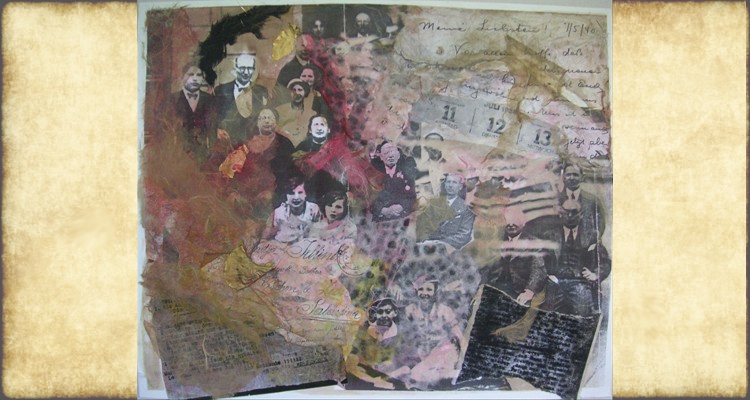 Mixed-media collage consisting of fragmented, altered photocopies of a
1933 Jellinek family group photo and of three family Shoah letters; as well as Asian papers,
hand-dyed with acrylic and watercolor paint; 14" x 16.75".
Mixed-media collage consisting of fragmented, altered photocopies of a
1933 Jellinek family group photo and of three family Shoah letters; as well as Asian papers,
hand-dyed with acrylic and watercolor paint; 14" x 16.75".
-
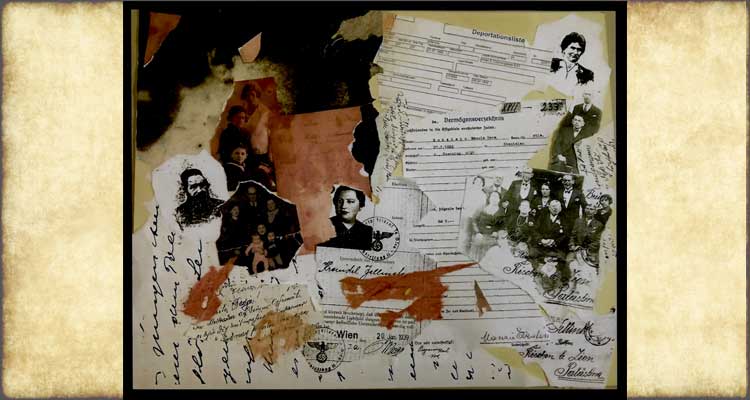 The title of this collage comes from Gisela Jellinek Schlesinger’s letter of March - May 1939 in which she implored:
“Why were we ripped apart? This disaster can never be undone.” I aimed to achieve —
chiefly through the use of visual form — an inkling of the feeling of the chaotic
and destructive forces that tragically wrested apart the Jellinek and Eckstein families.
Examples of my use of visual form include a disjointed composition, torn,
irregular, fragmented shapes, and the juxtaposition of strong contrasts of dark and light.
The title of this collage comes from Gisela Jellinek Schlesinger’s letter of March - May 1939 in which she implored:
“Why were we ripped apart? This disaster can never be undone.” I aimed to achieve —
chiefly through the use of visual form — an inkling of the feeling of the chaotic
and destructive forces that tragically wrested apart the Jellinek and Eckstein families.
Examples of my use of visual form include a disjointed composition, torn,
irregular, fragmented shapes, and the juxtaposition of strong contrasts of dark and light.
There is also the effect of the content, which consists of historic family photos
and documents, most of which have already been translated, identified and contextualized in
the Image and Documents sections of this website. Several generations of the
Jellinek and Eckstein families are represented, including members who managed to escape and
thus survive the Shoah, as well as those who were murdered or died as a result of the
conditions in their displaced settings. The collage also contains details of family letters,
the one extant envelope, as well as a Nazi-isssued passport and two deportation documents.
-
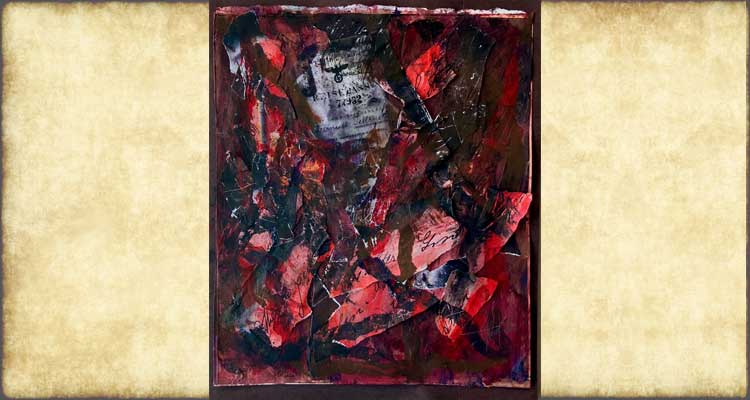 Mixed-media collage — consisting of acrylic paint, fragmented and painted photocopies
of the Jellinek Family Shoah Letters, and a key identifying fragment of Kreindel/Caroline Jellinek’s
passport out of Nazi-annexed Austria; 10.75" x 9.24"
Mixed-media collage — consisting of acrylic paint, fragmented and painted photocopies
of the Jellinek Family Shoah Letters, and a key identifying fragment of Kreindel/Caroline Jellinek’s
passport out of Nazi-annexed Austria; 10.75" x 9.24"
This image was created out of my feelings of the Holocaust’s wrenching, violent destruction and break-down of life,
order, morality, family bonds and much more.
I hope to evoke through the strong color, as well as the frantic,
confused juxtaposition of irregularly torn and jaggedly cut shapes and black/brown diagonal lines, as well as through
associations with the iconographic elements, a tiny glimpse for the viewer, into the Shoah’s bloody hell and horror.


 Left to Right: Max J., Berta Schafer J., Hugo J., Gisela J., Anna J., Siegmund J., Siegfried
J., Karl J.
Left to Right: Max J., Berta Schafer J., Hugo J., Gisela J., Anna J., Siegmund J., Siegfried
J., Karl J.


 This photo was probably taken between late 1914 and early 1917. There is
no inscription on the photo's reverse side.
This photo was probably taken between late 1914 and early 1917. There is
no inscription on the photo's reverse side.
 Translation, transcription & additional information by Wilma Iggers
and Esther Bates
Translation, transcription & additional information by Wilma Iggers
and Esther Bates
 This reproduction of an ink and watercolor wash painting was used as
backing material for Karl Jellinek's 1922 Doctor of Law diploma. It had been cut
slightly on its right side, to fit underneath the diploma. The print was discovered in 2007,
when the diploma was removed from its frame and glass covering in order to photograph it.
This reproduction of an ink and watercolor wash painting was used as
backing material for Karl Jellinek's 1922 Doctor of Law diploma. It had been cut
slightly on its right side, to fit underneath the diploma. The print was discovered in 2007,
when the diploma was removed from its frame and glass covering in order to photograph it.
 The formal opening ceremony of The Hebrew University of Jerusalem took
place on Mt. Scopus on April 1,1925. Karl Jellinek was present at this historic event,
representing the Zionist association he presided over at the time: Der Lese -und
Redehalle, jüdischer Hochschüler, in Wien (The Reading and Lecture Hall [Association] of
Jewish [University] Students in Vienna).
The formal opening ceremony of The Hebrew University of Jerusalem took
place on Mt. Scopus on April 1,1925. Karl Jellinek was present at this historic event,
representing the Zionist association he presided over at the time: Der Lese -und
Redehalle, jüdischer Hochschüler, in Wien (The Reading and Lecture Hall [Association] of
Jewish [University] Students in Vienna).

![ABOVE LEFT: March 1929, Group photo of members of the Zionist and Jewish cultural fraternity "<i>Die Lese - und Redehalle jüdischer Hochschüler in Wien</i>" -- (translated as "The Reading and Lecture Hall [Association] of Jewish [University] Students in Vienna" and hereafter referred to as the "Halle,") -- at the 70th Semester Commemoration/Celebration of its Founding. ABOVE LEFT: March 1929, Group photo of members of the Zionist and Jewish cultural fraternity "Die Lese - und Redehalle jüdischer Hochschüler in Wien" (translated as "The Reading and Lecture Hall [Association] of Jewish [University] Students in Vienna" and hereafter referred to as the "Halle,") -- at the 70th Semester Commemoration/Celebration of its Founding.](data1/images/18karlhalle.jpg)
 Photo taken in
front of Siegmund and Berta Schafer Jellinek's home/synagogue in Hollabrunn, Austria, on
the occasion of their 50th Wedding Anniversary.
Photo taken in
front of Siegmund and Berta Schafer Jellinek's home/synagogue in Hollabrunn, Austria, on
the occasion of their 50th Wedding Anniversary.
 Additional
photo taken in front of Siegmund and Berta Schafer Jellinek's home/synagogue in
Hollabrunn, Austria, on the occasion of their 50th Wedding Anniversary, and the occasion of
Gisella Nadja Jellinek's becoming Bat Mitzvah. Anna Jellinek Nadel's husband, Miron
Nadel, was the photographer.
Additional
photo taken in front of Siegmund and Berta Schafer Jellinek's home/synagogue in
Hollabrunn, Austria, on the occasion of their 50th Wedding Anniversary, and the occasion of
Gisella Nadja Jellinek's becoming Bat Mitzvah. Anna Jellinek Nadel's husband, Miron
Nadel, was the photographer.

 Daughters
left to right: Gisella Nadja, Berta, Anna. On occasion of Berta's Confirmation.
Daughters
left to right: Gisella Nadja, Berta, Anna. On occasion of Berta's Confirmation. Siegmund J. is wearing his cantorial attire and his government medal
received for counselling WWI veterans. His expression appears contemplative and somewhat
sad.
Siegmund J. is wearing his cantorial attire and his government medal
received for counselling WWI veterans. His expression appears contemplative and somewhat
sad.
 Siegmund J. in his
cantorial attire, and wearing the medal he had received from the Austrian government.
Hollabrunn, Austria,1937.
Siegmund J. in his
cantorial attire, and wearing the medal he had received from the Austrian government.
Hollabrunn, Austria,1937.
 It is interesting to see this example of Hugo's beautiful
calligraphic handwriting in modern script, instead of the old German Sütterlin
script that he also masterfully used in the body of his letters. We can tell from the
"BR" (Brünn) postmark that the letter was posted on the 25th day of a month in
1938. The more completely legible "Rishon LeTsion" postmark reveals that this
envelope arrived in Rishon on December 7, 1938. November is therefore most likely the
month in which this envelope was posted in Brünn, and the letter inside was most likely
Hugo's letter dated November 24, 1938. The Hebrew
words "Plugath - Bethar" in the address denote the Betar Zionist youth group
to which Nadja belonged. "Frl." is an abbreviation for
"Fräulein" (English: young lady, girl, Miss) and "Abs:"
is an abbreviation for "Absender" (Sender).
It is interesting to see this example of Hugo's beautiful
calligraphic handwriting in modern script, instead of the old German Sütterlin
script that he also masterfully used in the body of his letters. We can tell from the
"BR" (Brünn) postmark that the letter was posted on the 25th day of a month in
1938. The more completely legible "Rishon LeTsion" postmark reveals that this
envelope arrived in Rishon on December 7, 1938. November is therefore most likely the
month in which this envelope was posted in Brünn, and the letter inside was most likely
Hugo's letter dated November 24, 1938. The Hebrew
words "Plugath - Bethar" in the address denote the Betar Zionist youth group
to which Nadja belonged. "Frl." is an abbreviation for
"Fräulein" (English: young lady, girl, Miss) and "Abs:"
is an abbreviation for "Absender" (Sender).
 Photograph
taken before Karl J., Kreindel/Karla Eckstein J. and infant daughter, Michaela J.'s
life-saving departure from Vienna.
Photograph
taken before Karl J., Kreindel/Karla Eckstein J. and infant daughter, Michaela J.'s
life-saving departure from Vienna.
 Anna sent this small photo from Brünn to her uncle and aunt, Karl
and Karla Jellinek, in New York City. Anna is almost 15 years old here. She is not smiling,
but rather her face shows a mix of seriousness, sadness, disillusionment, resignation and
strength.
Anna sent this small photo from Brünn to her uncle and aunt, Karl
and Karla Jellinek, in New York City. Anna is almost 15 years old here. She is not smiling,
but rather her face shows a mix of seriousness, sadness, disillusionment, resignation and
strength.
 Berta sent this photo from Brünn to her uncle and aunt, Karl and
Karla Jellinek, in New York City. This small portrait photo of Berta shows her at about 16
1/2 years old, with an open, wistful and gently smiling expression.
Berta sent this photo from Brünn to her uncle and aunt, Karl and
Karla Jellinek, in New York City. This small portrait photo of Berta shows her at about 16
1/2 years old, with an open, wistful and gently smiling expression.
 This photo, officially titled, “Women Protesting Against the White
Paper, 18, May 1939,” was photographed by Rudolf Yunes. The photo appears here with the
permission of the KKL - JNF (Keren Kayemet LeIsrael - Jewish National Fund) Photo Archives.
This photo, officially titled, “Women Protesting Against the White
Paper, 18, May 1939,” was photographed by Rudolf Yunes. The photo appears here with the
permission of the KKL - JNF (Keren Kayemet LeIsrael - Jewish National Fund) Photo Archives.
 Photograph of Hugo J. and Fritzi Fränkel, hands clasped together,
on the day of their engagement in Brünn (Brno), Czechoslovakia.
Photograph of Hugo J. and Fritzi Fränkel, hands clasped together,
on the day of their engagement in Brünn (Brno), Czechoslovakia.
 Group wedding day photo taken on October 22, 1939, in Brno (Brünn).
The city was then in the "German Protectorate of Bohemia and Moravia,"
formerly western Czechoslovakia.
Group wedding day photo taken on October 22, 1939, in Brno (Brünn).
The city was then in the "German Protectorate of Bohemia and Moravia,"
formerly western Czechoslovakia.
 Additional wedding day group photo taken on October 22, 1939, in Brno
(Brünn), then in the "German Protectorate of Bohemia and Moravia,"
formerly western Czechoslovakia.
Additional wedding day group photo taken on October 22, 1939, in Brno
(Brünn), then in the "German Protectorate of Bohemia and Moravia,"
formerly western Czechoslovakia.
 The range of facial expressions, especially Fritzi's, in these and
in the wedding day group photos, reflects the fact that this wedding occurred fifty-two days
after the outbreak of WWII and approximately seven months into the Nazi occupation of Brno.
Overall, however, Hugo and Fritzi's love and marriage seem, to this writer, to be a
testament to the strength of their resilience and spirit of defiance.
The range of facial expressions, especially Fritzi's, in these and
in the wedding day group photos, reflects the fact that this wedding occurred fifty-two days
after the outbreak of WWII and approximately seven months into the Nazi occupation of Brno.
Overall, however, Hugo and Fritzi's love and marriage seem, to this writer, to be a
testament to the strength of their resilience and spirit of defiance.
 It is impossible to reconcile this portrait of seventeen-year-old Berta, whose smiling eyes
and lips are so imbued with life and anticipation of life, with her murder at Auschwitz less
than three years later. Here, we see a beautiful young woman, looking innocently and
engagingly into a studio camera, unaware of the terror and death that lay ahead for her, her
sister Anna, her father, Hugo and her new stepmother, Fritzi.
It is impossible to reconcile this portrait of seventeen-year-old Berta, whose smiling eyes
and lips are so imbued with life and anticipation of life, with her murder at Auschwitz less
than three years later. Here, we see a beautiful young woman, looking innocently and
engagingly into a studio camera, unaware of the terror and death that lay ahead for her, her
sister Anna, her father, Hugo and her new stepmother, Fritzi.
 The above photos,
shot during Max's nearly eight years in exile in Shanghai, China, contrast with
Max's Biography page photo, shot in pre-Nazi Vienna,
in which he appears self-confident and debonair. After reading of Max's hardships in
Shanghai, in his letters of April 23, 1939 and May 16, 1939, one can well understand Max's loss of
weight and much older appearance in these three photos.
The above photos,
shot during Max's nearly eight years in exile in Shanghai, China, contrast with
Max's Biography page photo, shot in pre-Nazi Vienna,
in which he appears self-confident and debonair. After reading of Max's hardships in
Shanghai, in his letters of April 23, 1939 and May 16, 1939, one can well understand Max's loss of
weight and much older appearance in these three photos.
 Siegfried appears posed, but relaxed and somewhat detached in this
studio portrait.
Siegfried appears posed, but relaxed and somewhat detached in this
studio portrait.
 It seems remarkable that Erich appears to be unscarred and
smiling in a warm, relaxed and confident manner, when one considers that this studio
portrait photo could only have been taken after a maximum of thirteen months since
the end of Erich’s traumatic imprisonment in Auschwitz-Birkenau (1942 - 45), and four
years since Erich’s deportation, at age 17, from Vienna to Auschwitz, and his witnessing his
mother’s murder. [Read more about this in the Biography of Erich’s
father, Siegfried Jellinek.] The original photo was found among Karl Jellinek’s
saved letters, photos and documents, thirty-three years after Karl’s death in New York City
in 1977.
It seems remarkable that Erich appears to be unscarred and
smiling in a warm, relaxed and confident manner, when one considers that this studio
portrait photo could only have been taken after a maximum of thirteen months since
the end of Erich’s traumatic imprisonment in Auschwitz-Birkenau (1942 - 45), and four
years since Erich’s deportation, at age 17, from Vienna to Auschwitz, and his witnessing his
mother’s murder. [Read more about this in the Biography of Erich’s
father, Siegfried Jellinek.] The original photo was found among Karl Jellinek’s
saved letters, photos and documents, thirty-three years after Karl’s death in New York City
in 1977. The two portrait drawings shown above, are part of a group of seven,
larger than life drawings that I created while thinking about my grandmother, Mathilde
Nanzie Eckstein’s last days and moments before her murder by the Nazis in 1942. I thought
about what expression might have been on Mathilde’s and other womens’ faces, reflecting or
hiding what was in their hearts and minds as they walked to their deaths.
The two portrait drawings shown above, are part of a group of seven,
larger than life drawings that I created while thinking about my grandmother, Mathilde
Nanzie Eckstein’s last days and moments before her murder by the Nazis in 1942. I thought
about what expression might have been on Mathilde’s and other womens’ faces, reflecting or
hiding what was in their hearts and minds as they walked to their deaths. The three portrait drawings shown above are also part of the group of
eight drawings titled, From Deep Inside the Darkness. Two other drawings in this
group are shown on the preceding Image page, along with a brief statement about my creative
process for all seven of these art works and memorial tributes.
The three portrait drawings shown above are also part of the group of
eight drawings titled, From Deep Inside the Darkness. Two other drawings in this
group are shown on the preceding Image page, along with a brief statement about my creative
process for all seven of these art works and memorial tributes.
 Media: oil, and collage of fragmented photocopies of Kreindel/Caroline
Jellinek's passport out of the "Deutsches Reich", Kreindel/Caroline’s
"Heimatschein" (Certificate of Origin), war-time letters, as well as mylar on
canvas; approx.17" x 30.5".
Media: oil, and collage of fragmented photocopies of Kreindel/Caroline
Jellinek's passport out of the "Deutsches Reich", Kreindel/Caroline’s
"Heimatschein" (Certificate of Origin), war-time letters, as well as mylar on
canvas; approx.17" x 30.5". Mixed-media collage consisting of fragmented, altered photocopies of a
1933 Jellinek family group photo and of three family Shoah letters; as well as Asian papers,
hand-dyed with acrylic and watercolor paint; 14" x 16.75".
Mixed-media collage consisting of fragmented, altered photocopies of a
1933 Jellinek family group photo and of three family Shoah letters; as well as Asian papers,
hand-dyed with acrylic and watercolor paint; 14" x 16.75".
 The title of this collage comes from Gisela Jellinek Schlesinger’s letter of March - May 1939 in which she implored:
“Why were we ripped apart? This disaster can never be undone.” I aimed to achieve —
chiefly through the use of visual form — an inkling of the feeling of the chaotic
and destructive forces that tragically wrested apart the Jellinek and Eckstein families.
Examples of my use of visual form include a disjointed composition, torn,
irregular, fragmented shapes, and the juxtaposition of strong contrasts of dark and light.
The title of this collage comes from Gisela Jellinek Schlesinger’s letter of March - May 1939 in which she implored:
“Why were we ripped apart? This disaster can never be undone.” I aimed to achieve —
chiefly through the use of visual form — an inkling of the feeling of the chaotic
and destructive forces that tragically wrested apart the Jellinek and Eckstein families.
Examples of my use of visual form include a disjointed composition, torn,
irregular, fragmented shapes, and the juxtaposition of strong contrasts of dark and light.
 Mixed-media collage — consisting of acrylic paint, fragmented and painted photocopies
of the Jellinek Family Shoah Letters, and a key identifying fragment of Kreindel/Caroline Jellinek’s
passport out of Nazi-annexed Austria; 10.75" x 9.24"
Mixed-media collage — consisting of acrylic paint, fragmented and painted photocopies
of the Jellinek Family Shoah Letters, and a key identifying fragment of Kreindel/Caroline Jellinek’s
passport out of Nazi-annexed Austria; 10.75" x 9.24"